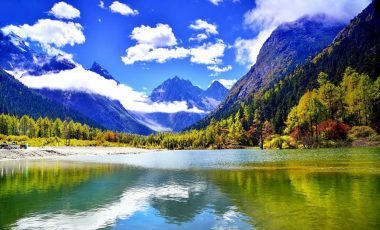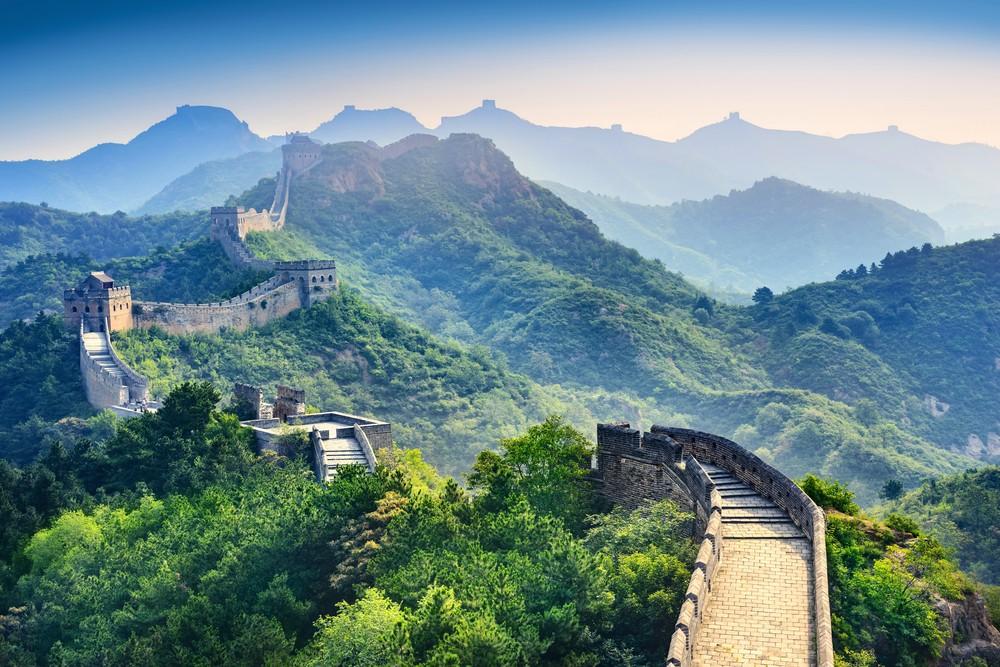China, the fourth largest country in the world in terms of area, is extremely versatile and has a lot to offer its visitors.
The varied landscape is characterized by high mountain ranges and high plateaus, especially in the west, while in the south and east there are coasts with a partly tropical or subtropical climate that invite you to swim. But steppes and deserts as well as impressive river landscapes are also part of China. So if you want to discover the unique nature of China, you have numerous options.

The Tibetan highlands, surrounded by the Himalayas and Kunlun Shan, fascinate with wide grasslands and beautiful Tibetan monasteries. A special visitor magnet is the province of Sichuan. It has plenty of attractions, including the deep blue lakes and thundering waterfalls of the Jiuzhaigou Valley Landscape Park. The Huanglong National Park with its limestone deposits and the turquoise shimmering sinter basins as well as the Great Buddha of Leshan – the largest Buddha statue made of stone – are also worth a visit. In the provincial capital of Chengdu, visitors can finally admire the Chinese national symbol in the panda breeding station.
But not only the panda is part of China’s unique fauna. Due to the different climate zones, China has an extremely rich flora and fauna, which is protected in the country’s numerous national parks.
The karst landscapes in southern China are also charming, especially the rock formations near Guilin and the natural sculptures of the Shilin Stone Forest.

Of course, China also stands for imposing buildings such as the Great Wall of China, which stretches for more than 20,000 kilometers through the country. Like the tomb of Emperor Qin Shihuangdi near the city of Xi’an with its huge terracotta army, it is a UNESCO World Heritage Site.
The vibrant metropolises are also part of China. In the numerous megacities of the most populous country, tradition and modernity meet, which often promises interesting contrasts. In the capital Beijing , for example, you will find the Forbidden City with the Imperial Palace from the 15th century as well as modern skyscrapers. Other attractions in the city include Tiananmen Square, the Temple of Heaven, and the Ming Tombs. A world-famous culinary specialty of the city is the Peking duck, which is not to be missed here.
China is a fascinating destination that seamlessly combines tradition and modernity. With a history that spans thousands of years and an impressive variety of landscapes and cultures, China offers countless experiences for travelers. In this article, I will introduce you to some of the most important sights and practical tips for your trip.
The most popular cities in China
Beijing – The capital full of history
Beijing, the capital of China, is a must-see for any China traveler. Here are some of the most important historical sites in the country:
- The Forbidden City: A majestic palace complex in the heart of Beijing, once reserved for the emperors of the Ming and Qing dynasties.
- Tiananmen Square: One of the largest public squares in the world, surrounded by monumental buildings such as the Mausoleum of Mao Zedong and the National Museum of China.
- The Temple of Heaven: An impressive example of Chinese architecture and a symbol of Beijing’s rich spiritual history.
For more information and tickets, visit the official Beijing tourism website.
Shanghai – The beating heart of modernity
Shanghai is known for its stunning skyline and dynamic city life. Highlights include:
- The Bund: A picturesque waterfront with colonial buildings that offers spectacular views of Pudong’s modern skyline.
- The Oriental Pearl Tower: An iconic television tower with observation decks that offer unparalleled views of the city.
- Shanghai’s Old Town: A fascinating contrast to the modern city with traditional Chinese gardens and historic buildings.
More information can be found on the official tourism website of Shanghai.
Xi’an – The Cradle of Chinese Civilization
Xi’an is known as the starting point of the ancient Silk Road and home to the world-famous Terracotta Army:
- The Terracotta Army: This archaeological site is home to thousands of life-size terracotta soldiers guarding the tomb of China’s first emperor, Qin Shi Huang.
- Xi’an City Wall: One of the best-preserved city walls in China, offering fantastic views of the city.
- The Big Wild Goose Pagoda: An important Buddhist structure from the Tang Dynasty.
Visit the Xi’an tourism website for more details.
Guilin – Natural Wonders in the South of China
Guilin is famous for its stunning karst landscape and idyllic river landscapes:
- The Li River: A boat trip on the Li River offers scenic views of impressive karst mountains and traditional villages.
- The Longji Rice Terraces: These spectacular terraced fields offer a glimpse of traditional agricultural life and are especially stunning in spring and autumn.
For more information, visit the Guilin tourism website.
Practical tips for your trip to China
- Visa: Make sure you apply for a China visa on time. The requirements vary depending on your nationality.
- Language: Although English is often spoken in tourist areas, it is helpful to learn some basic Mandarin phrases or use a translation app.
- Currency: The official currency is the Chinese Yuan (CNY). It is advisable to carry some cash with you, as credit cards are not accepted everywhere.
- Internet and communication: In China, some international websites and services are blocked. Use VPN services to gain access to the sites you need.
With the large rivers Yangtze River, Mekong and the Yellow River, China also has fascinating river landscapes that can be explored by boat.
Typical for the country are also tea plantations and rice terraces, pagodas and temples and friendly people. To get to know the culture of the country, for example, a trip to the villages as well as participation in regional festivals or a traditional tea ceremony is recommended. In any case, a lot of interesting impressions await the China traveler.
Travel information China
| Capital | Beijing |
|---|---|
| Form of government | Republic, one-party socialist system |
| Currency | Renminbi (CNY) |
| Area | approx. 9,596,960 km² |
| Population | approx. 1,379,303,000 (as of 2017) |
| Languages | Chinese |
| Electricity grid | 220 Volt / 50 Hz |
| Area code | +86 |
| Time zone | UTC+8 UTC+3 (March to October) |


